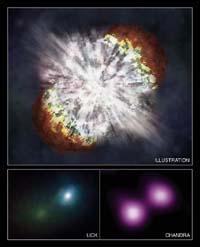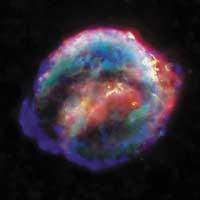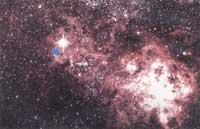Garik in Israel: "The nucleosyesis of an explosion needs to create heavy elements"
2007/06/01 Roa Zubia, Guillermo - Elhuyar Zientzia Iturria: Elhuyar aldizkaria
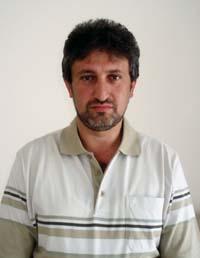
I was about 15 years old when I started reading about astronomy. And I remember very well that one day I saw with my friends a sci-fi film in the Soviet Union. Before that day I only saw western style movies, my favorite movies. But that sci-fi film revolutionized my world. I was fascinated by the consequences of the theory of relativity. Especially I was surprised to know that if it was moving close to the speed of light time was slowing down. He was totally surprised.
This enigma led me to read sci-fi books. I read every day and night, all those who caught me. Then I started reading about astronomy. However, I had a very low level of mathematics and physics, and that's why I couldn't go to college after finishing high school. For a year I had to work in the village theater, while learning mathematics and physics at home. I had to study for a year to know enough to enter the Department of Physics at Jereban State University, Armenia. I became one of the best students in the department and, after completing my studies, I started a doctorate.
I did my doctoral thesis at the Biukaran observatory in Armenia. The thesis director was Professor Victor Ambartsumian, one of the most important astronomers in the world. In Ambartsumia he was president of the International Astronomical Association and the International Commission of Scientific Associations. He founded a school of theoretical astrophysics of the Soviet Union.
After finishing my doctorate in Armenia, I spent several years working in Holland, Belgium and Australia. Finally I arrived in the Canaries in 1997.
I know in Armenia a. C. C. III. That we were astronomers of the twentieth century. There are many ancient manuscripts in our museums. In addition, Armenia has an old observatory -- 10,000 years old or earlier. It is similar to the famous English Stonehenge, so many scientists look for ties between both. Armenians have worked for thousands of years in astronomy. There are other evidences such as Armenian names for constellations and planets of the Solar System.
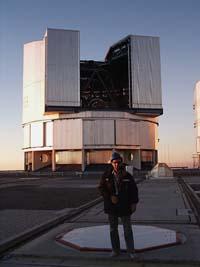
Well, if you work on observation and want to be "close" to telescopes there are few options. Surely you will have to choose between Canaries, Chile or Hawaii. These are the best observatories in the world in astronomy.
My job is to investigate how chemical elements are created in space and how they evolve, in addition to developing observation tests that help develop theoretical models.
The life of each star begins with a given mass, a determined rotation speed, and a specific chemical composition. These three parameters define the evolution of the star.
They are very different! For example, some heavy metals -- titanium, uranium, europio, etc.- cannot be created by a mass star like the Sun. For this purpose, stars of at least ten times more mass are needed.
Mainly yes. In some cases, the initial rotation speed of the star can also influence the final products of this element factory. And the initial chemical composition can also change the final composition (i.e., the evolution of the star). However, the most important parameter is the mass.
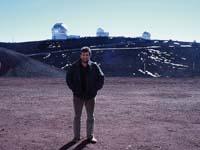
Small energy workshop. The sun can form light elements such as carbon and nitrogen, but it will never form nickel, silver, or gold.
The reason is historical. Iron is not special in astrophysics. The iron of the stars is easy to measure and other elements of the iron group are not detected or detected with little precision.
It is only a definition. However, it must be taken into account that the elements heavier than iron are not formed in massive stars by hydrostatic thermonuclear reactions. The formation of these elements requires at least the nucleosyesis of an explosion.
Heavy elements (called s-elements, such as barium) can be formed by a slow capture of neutrons, in layers of stars with mass of the Sun that have evolved a lot. These stars are called IGB. On the other hand, heavy elements can also form in expansion reactions, both in the interstellar environment and in the vicinity of stars that emit X-rays or gamma.
In very small proportion. Most of the elements present in the supernovae have been created previously in hydrostatic thermonuclear reactions such as oxygen, magnesium, sulfur or silicon. The supernova contributes to the spatial dispersion of these elements. They account for 90% of the matter launched.
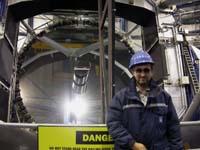
The matter released appears in the footprints of the supernovae. You can study the spectrum of these brands and measure the abundance of chemical elements. Spectra of stars close to the supernode can also be studied (for example, in binary systems). It is possible that a part of the matter emitted has been absorbed by the star and mixed with the matter of the atmosphere.
In no case. Uranium atoms are found in space, so they can be present in any astronomical body: asteroids, comets, planets outside the solar system, etc. Heavy atoms have arisen in many generations of supernovae in our galaxy. They have gathered in space throughout the year. Therefore, they will be present in any body that occurs with this matter.
They don't. They are among the stars in a state of gas or dust. The planets and stars are made of this material (protostar material), so they have these elements from the beginning. Therefore, the chemical composition of the Sun is the same as that of this matter.
There are many types of supernovae. We do not know what type produces a large amount of a certain chemical element and what does not. Theoretical models are not accurate and are not easy to investigate through observations.

Gai honi buruzko eduki gehiago
Elhuyarrek garatutako teknologia




